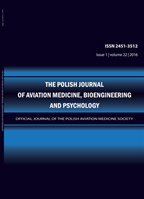2013, Volume 19, Issue 4
Antisaccades and Executive Control
Adam Tarnowski1
-------------------------------------------------------------------------------------------------
1Department of Psychology, Military Institute of Aviation Medicine
Autor korenspondencyjny: Adam Tarnowski; Department of Psychology, Military Institute of Aviation Medicine; email: tarnowski[at]wiml.waw.pl
Full text
Streszczenie
Introduction. Directing the eye gaze to the opposite side when a stimulus appears, demands inhibition of natural reflex and intentional control when performing the movement. Under normal conditions, the reflexive saccades are guided by attention map, combination of visual saliency and task relevance. In the antisaccade task a confl ict between task relevance and saliency maps must be resolved, thus the problem involves the central executive resources. Methods. The study involved 26 individuals, 12 men and 14 women. The saccadic reaction times were measured in trials involving 5 different verbal memory workload levels. Results. Results have shown only a weak effect of memory workload, the latencies were longer when memory was not overloaded. Also, the proportion of saccades in the wrong (toward the stimuli) direction remained nearly constant when the memory workload increased. Discussion. The experiment results suggest that the introduction of a memory task reduces the executive resources involved in the antitask. Conclusions. It is difficult to maintain attention and gaze on a fixation point for a few seconds between the stimuli. In a dual-task paradigm, increasing the diffi culty of one task does not necessarily increase the processing time of the second task.
Słowa kluczowe
antisaccades, antisaccades, saccadometry, saccadometry
